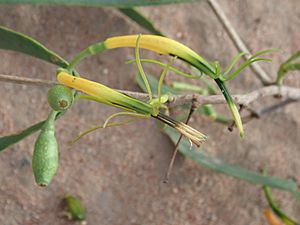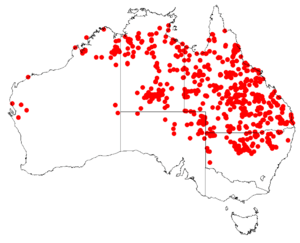Lysiana subfalcata facts for kids
Quick facts for kids Lysiana subfalcata |
|
|---|---|
 |
|
| Lysiana subfalcata | |
| Scientific classification | |
| Genus: |
Lysiana
|
| Species: |
subfalcata
|
 |
|
| Occurrence data from AVH | |
| Synonyms | |
Lysiana subfalcata, often called the Northern mistletoe, is a cool plant that grows on other plants! It's a type of hemi-parasitic shrub, which means it gets some of its food and water from its host plant, but it can also make its own food using sunlight. You can find this unique mistletoe all over mainland Australia, except in Victoria. It belongs to the Loranthaceae family, which is a big family of mistletoes.
Contents
What Does It Look Like?
The Northern mistletoe is a smooth plant. It doesn't have any tiny hairs on its branches, leaves, or flowers. Its leaves are usually grey-green and shaped a bit like a spoon, wider at the tip and narrower at the base. They can be anywhere from 2 to 12 centimeters long and 4 to 20 millimeters wide. Sometimes, they don't even have a clear middle vein!
The flowers of this mistletoe grow in pairs. They have a small cup-like part called a calyx, which is either smooth or only slightly divided. The main part of the flower, called the corolla, is like a tube and can be 2.5 to 5 centimeters long. When the flowers are fully grown, they are usually bright red. Sometimes, they can be yellow, or even have green or black tips.
After flowering, the plant produces fruits. These fruits are juicy, yellowish, and about 8 to 14 millimeters long. They are usually pale and a bit see-through.
When Does It Flower and Fruit?
This mistletoe can flower and produce fruit at different times depending on where it grows. In South Australia, you might see it flowering and fruiting all year round! However, in the Northern Territory, it usually flowers from March to October and fruits from April to October.
Where Does It Live and What Does It Grow On?
The Northern mistletoe likes to live in open forests and woodlands. It can also be found on rocky or gravelly hills, sandy plains, and near places where water flows sometimes.
Since it's a hemi-parasitic plant, it needs a host plant to grow on. It attaches itself to other trees and shrubs to get some of its nutrients. Some of its favorite host plants include species from the Lysiphyllum, Eucalyptus, and Acacia groups, especially in Western Australia. In South Australia and New South Wales, it often grows on plants like Atalaya, Alectryon, Bauhinia, Santalum, and plants from the Casuarinaceae family. In the Northern Territory, you might find it on Acacia, Alectryon, Atalaya, Capparis, Eucalyptus, Grevillea, Pittosporum, Senna, and Vachellia species.
How People Use It
Aboriginal groups have used Lysiana subfalcata for many different purposes for a very long time:
- The Alyawarr people use it for food and as a source of water.
- The Anmatyerr people use it for firewood and to make toys and weapons.
- The Kaytetye people eat the fruit.
- The Pintupi Luritja people also use the fruit for food.
- The Pitjantjatjara people use the fruit as food and to make sticky gums. They also use the plant as food for animals, for shelter and shade, to make toys and weapons, and for fish poisons and traps.
- The Waramangu people use it for weapons and tools, and for fish-poisons and traps.
- The Warlpiri people use it as food, as plant food for animals, and the plant itself for shade and shelter, to make weapons and tools, and for fish-poisons and traps.
- The Western Arrernte people use the plant for shade and shelter.
Images for kids
-
on Atalaya hemiglauca, Narran River floodplain, NSW




